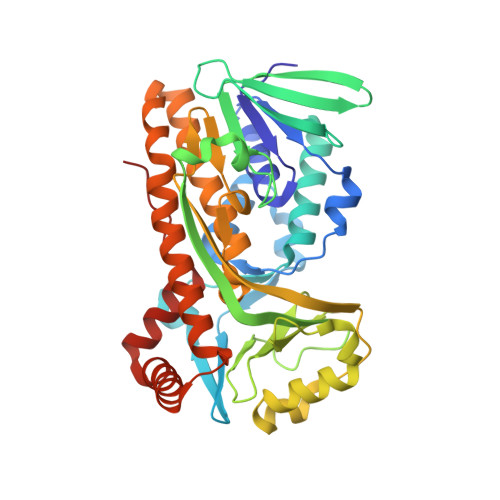Protein and ligand dynamics in 4-hydroxybenzoate hydroxylase.
Wang, J., Ortiz-Maldonado, M., Entsch, B., Massey, V., Ballou, D., Gatti, D.L.(2002) Proc Natl Acad Sci U S A 99: 608-613
- PubMed: 11805318
- DOI: https://doi.org/10.1073/pnas.022640199
- Primary Citation of Related Structures:
1K0I, 1K0J, 1K0L - PubMed Abstract:
para-Hydroxybenzoate hydroxylase catalyzes a two-step reaction that demands precise control of solvent access to the catalytic site. The first step of the reaction, reduction of flavin by NADPH, requires access to solvent. The second step, oxygenation of reduced flavin to a flavin C4a-hydroperoxide that transfers the hydroxyl group to the substrate, requires that solvent be excluded to prevent breakdown of the hydroperoxide to oxidized flavin and hydrogen peroxide. These conflicting requirements are met by the coordination of multiple movements involving the protein, the two cofactors, and the substrate. Here, using the R220Q mutant form of para-hydroxybenzoate hydroxylase, we show that in the absence of substrate, the large beta alpha beta domain (residues 1-180) and the smaller sheet domain (residues 180-270) separate slightly, and the flavin swings out to a more exposed position to open an aqueous channel from the solvent to the protein interior. Substrate entry occurs by first binding at a surface site and then sliding into the protein interior. In our study of this mutant, the structure of the complex with pyridine nucleotide was obtained. This cofactor binds in an extended conformation at the enzyme surface in a groove that crosses the binding site of FAD. We postulate that for stereospecific reduction, the flavin swings to an out position and NADPH assumes a folded conformation that brings its nicotinamide moiety into close contact with the isoalloxazine moiety of the flavin. This work clearly shows how complex dynamics can play a central role in catalysis by enzymes.
Organizational Affiliation:
Department of Biochemistry and Molecular Biology, Wayne State University School of Medicine, Detroit, MI 48201, USA.

















